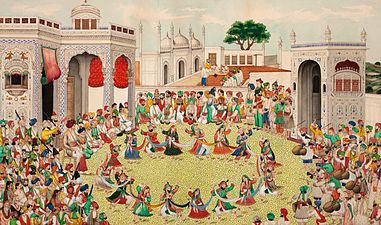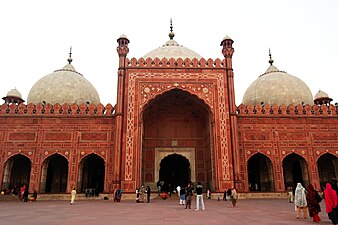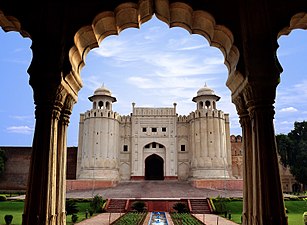Religion in Lahore
It is estimated that the city of Lahore, Pakistan, has a Muslim majority with 94.7% and Christian minority constitute 5.1% of the population and rest Sikhs and Hindus constitute the remaining 0.2%. There is also a small but longstanding Zoroastrian community.[1]
Before Partition
[edit]Prior to the partition of India in 1947, a third of Lahore district's population was Hindu and Sikh. Hindus and Sikhs used to reside in 'distinct enclaves'. The city's Hindu and Sikh population left en masse during the partition and shifted to East Punjab and Delhi in India. In the process, Lahore lost its entire Hindu and Sikh population. The emigrants were replaced by Muslim refugees from India. Muslim refugees and locals competed for ownership over abandoned Hindu and Sikh property.[5]
Lahore District
[edit]| Religious group |
1901[6] | 1911[7][8] | 1921[9] | 1931[10] | 1941[4] | |||||
|---|---|---|---|---|---|---|---|---|---|---|
| Pop. | % | Pop. | % | Pop. | % | Pop. | % | Pop. | % | |
| Islam |
717,519 | 61.74% | 626,271 | 60.44% | 647,640 | 57.25% | 815,820 | 59.18% | 1,027,772 | 60.62% |
| Hinduism |
276,375 | 23.78% | 217,609 | 21% | 255,690 | 22.6% | 259,725 | 18.84% | 284,689 | 16.79% |
| Sikhism |
159,701 | 13.74% | 169,008 | 16.31% | 179,975 | 15.91% | 244,304 | 17.72% | 310,646 | 18.32% |
| Christianity |
7,296 | 0.63% | 21,781 | 2.1% | 46,454 | 4.11% | 57,097 | 4.14% | 70,147 | 4.14% |
| Jainism |
1,047 | 0.09% | 1,139 | 0.11% | 1,209 | 0.11% | 1,450 | 0.11% | 1,951 | 0.12% |
| Zoroastrianism |
171 | 0.01% | 209 | 0.02% | 179 | 0.02% | 159 | 0.01% | 136 | 0.01% |
| Buddhism |
0 | 0% | 128 | 0.01% | 170 | 0.02% | 14 | 0% | 32 | 0% |
| Judaism |
0 | 0% | 13 | 0% | 13 | 0% | 1 | 0% | 2 | 0% |
| Others | 0 | 0% | 0 | 0% | 6 | 0% | 0 | 0% | 0 | 0% |
| Total population | 1,162,109 | 100% | 1,036,158 | 100% | 1,131,336 | 100% | 1,378,570 | 100% | 1,695,375 | 100% |
| Note: British Punjab province era district borders are not an exact match in the present-day due to various bifurcations to district borders — which since created new districts — throughout the historic Punjab Province region during the post-independence era that have taken into account population increases. | ||||||||||
| Tehsil | Islam |
Hinduism |
Sikhism |
Christianity |
Jainism |
Others[b] | Total | |||||||
|---|---|---|---|---|---|---|---|---|---|---|---|---|---|---|
| Pop. | % | Pop. | % | Pop. | % | Pop. | % | Pop. | % | Pop. | % | Pop. | % | |
| Lahore Tehsil | 290,325 | 56.31% | 139,215 | 27% | 57,337 | 11.12% | 27,898 | 5.41% | 478 | 0.09% | 360 | 0.07% | 515,613 | 100% |
| Chunian Tehsil | 179,399 | 60.71% | 61,475 | 20.8% | 49,151 | 16.63% | 5,408 | 1.83% | 76 | 0.03% | 0 | 0% | 295,509 | 100% |
| Kasur Tehsil | 177,916 | 55.56% | 55,000 | 17.18% | 73,487 | 22.95% | 13,154 | 4.11% | 655 | 0.2% | 2 | 0% | 320,214 | 100% |
| Note: British Punjab province era tehsil borders are not an exact match in the present-day due to various bifurcations to tehsil borders — which since created new tehsils — throughout the historic Punjab Province region during the post-independence era that have taken into account population increases. | ||||||||||||||
| Tehsil | Hinduism |
Islam |
Sikhism |
Christianity |
Jainism |
Others[c] | Total | |||||||
|---|---|---|---|---|---|---|---|---|---|---|---|---|---|---|
| Pop. | % | Pop. | % | Pop. | % | Pop. | % | Pop. | % | Pop. | % | Pop. | % | |
| Lahore Tehsil | 193,714 | 21.77% | 552,907 | 62.12% | 103,312 | 11.61% | 37,442 | 4.21% | 1,095 | 0.12% | 2,458 | 0.28% | 890,024 | 100% |
| Chunian Tehsil | 56,293 | 14.4% | 237,829 | 60.85% | 83,888 | 21.46% | 11,730 | 3% | 47 | 0.01% | 165 | 0.04% | 390,852 | 100% |
| Kasur Tehsil | 34,682 | 8.37% | 237,036 | 57.19% | 123,446 | 29.78% | 18,514 | 4.47% | 809 | 0.2% | 8 | 0% | 414,499 | 100% |
| Note1: British Punjab province era tehsil borders are not an exact match in the present-day due to various bifurcations to tehsil borders — which since created new tehsils — throughout the historic Punjab Province region during the post-independence era that have taken into account population increases. Note2: Tehsil religious breakdown figures for Christianity only includes local Christians, labeled as "Indian Christians" on census. Does not include Anglo-Indian Christians or British Christians, who were classified under "Other" category. | ||||||||||||||
Lahore City
[edit]| Religious group |
1881[11][12]: 520 | 1891[13]: 68 | 1901[14]: 44 | 1911[15]: 20 | 1921[16]: 23 | 1931[17]: 26 | 1941[18]: 32 | |||||||||
|---|---|---|---|---|---|---|---|---|---|---|---|---|---|---|---|---|
| Pop. | % | Pop. | % | Pop. | % | Pop. | % | Pop. | % | Pop. | % | Pop. | % | |||
| Islam |
86,413 | 57.85% | 102,280 | 57.83% | 119,601 | 58.93% | 129,801 | 56.76% | 149,044 | 52.89% | 249,315 | 58.01% | 433,170 | 64.49% | ||
| Hinduism |
53,641 | 35.91% | 62,077 | 35.1% | 70,196 | 34.59% | 77,267 | 33.79% | 107,783 | 38.25% | 139,125 | 32.37% | 179,422 | 26.71% | ||
| Sikhism |
4,627 | 3.1% | 7,306 | 4.13% | 7,023 | 3.46% | 12,877 | 5.63% | 12,833 | 4.55% | 23,477 | 5.46% | 34,021 | 5.07% | ||
| Christianity |
529[d] | 0.35% | 4,697 | 2.66% | 5,558 | 2.74% | 8,436 | 3.69% | 11,287 | 4.01% | 16,875 | 3.93% | 21,495 | 3.2% | ||
| Jainism |
227 | 0.15% | 339 | 0.19% | 420 | 0.21% | 467 | 0.2% | 474 | 0.17% | 791 | 0.18% | 1,094 | 0.16% | ||
| Zoroastrianism |
— | — | 132 | 0.07% | 166 | 0.08% | 198 | 0.09% | 177 | 0.06% | 150 | 0.03% | — | — | ||
| Judaism |
— | — | 14 | 0.01% | — | — | 13 | 0.01% | 13 | 0% | 0 | 0% | — | — | ||
| Buddhism |
— | — | 0 | 0% | 0 | 0% | 128 | 0.06% | 170 | 0.06% | 14 | 0% | — | — | ||
| Others | 3,932 | 2.63% | 9 | 0.01% | 0 | 0% | 0 | 0% | 0 | 0% | 0 | 0% | 2,457 | 0.37% | ||
| Total population | 149,369 | 100% | 176,854 | 100% | 202,964 | 100% | 228,687 | 100% | 281,781 | 100% | 429,747 | 100% | 671,659 | 100% | ||
| Note: 1881-1941: Data for the entirety of the town of Lahore, which included Lahore Municipality and Lahore Cantonment.[18]: 32 | ||||||||||||||||
Religious heritage
[edit]According to a Hindu legend, Lahore was once named Lavapura,[19] after Lava, son of Lord Rama, Hindu God from Ramayana as one of etymological theory of Lahore.[20][21] A vacant temple, the Lava Temple, dedicated to this figure is contained inside the Lahore Fort.[22][23]
The first Persian text on Sufism was written, by Hazrat Data Ganj Bakhsh Shaykh Abul Hasan 'Ali Hujwiri R.A. in Lahore which became a major source for early Sufi thought and practice. Hazrat e Hujwiri R.A's tomb in Lahore is one of the major Sufi shrines in the subcontinent.[24] Several other leading Sufi saints are buried in Lahore.[25] These Sufi shrines have contributed to making Lahore an important place of pilgrimage.[26] During the Mughal era, several impressive buildings including mosques were constructed, contributing to the city's rich Mughal heritage.[27][28]
The city is also of significant importance to the Sikhs of Punjab region who call it Lahore-Sharif.[29][30] Some of Sikhism's holiest sites are situated inside Lahore.[31]
Gallery
[edit]-
Sher Singh in Lahore
-
Maharajah Duleep Singh, entering his palace in Lahore.
-
Inside the Badshahi Mosque
Notes
[edit]- ^ a b c 1931-1941: Including Ad-Dharmis
- ^ Including Buddhism, Zoroastrianism, Judaism, Tribals, others, or not stated
- ^ Including Anglo-Indian Christians, British Christians, Buddhism, Zoroastrianism, Judaism, Tribals, others, or not stated
- ^ Only includes protestant population.[11]: 152
References
[edit]- ^ "Largest Christian Community of Pakistan resides in Lahore District". christiansinpakistan.com. Archived from the original on January 5, 2013. Retrieved 11 September 2016.
{{cite web}}: CS1 maint: unfit URL (link) - ^ http://pakgeotagging.blogspot.in/2014/10/partition-of-punjab-in-2017.html [user-generated source]
- ^ "Final Results (Census-2017)". Archived from the original on 17 October 2021. Retrieved 17 January 2023.
- ^ a b c "Census of India, 1941. Vol. 6, Punjab". 1941. p. 42. JSTOR saoa.crl.28215541. Retrieved 23 March 2024.
- ^ Gandhi, Usha (2007-06-01). "Review of Talbot, Ian, Divided Cities: Partition and Its Aftermath in Lahore and Amritsar, 1947-1957". www.h-net.org. Retrieved 2017-04-05.
- ^ "Census of India 1901. [Vol. 17A]. Imperial tables, I-VIII, X-XV, XVII and XVIII for the Punjab, with the native states under the political control of the Punjab Government, and for the North-west Frontier Province". 1901. p. 34. JSTOR saoa.crl.25363739. Retrieved 23 March 2024.
- ^ "Census of India 1911. Vol. 14, Punjab. Pt. 2, Tables". 1911. p. 27. JSTOR saoa.crl.25393788. Retrieved 23 March 2024.
- ^ Kaul, Harikishan (1911). "Census Of India 1911 Punjab Vol XIV Part II". p. 27. Retrieved 23 March 2024.
- ^ a b "Census of India 1921. Vol. 15, Punjab and Delhi. Pt. 2, Tables". 1921. p. 29. JSTOR saoa.crl.25430165. Retrieved 23 March 2024.
- ^ "Census of India 1931. Vol. 17, Punjab. Pt. 2, Tables". 1931. p. 277. JSTOR saoa.crl.25793242. Retrieved 23 March 2024.
- ^ a b "Census of India, 1881 Report on the Census of the Panjáb Taken on the 17th of February 1881, vol. I." 1881. JSTOR saoa.crl.25057656. Retrieved 14 January 2024.
- ^ "Census of India, 1881 Report on the Census of the Panjáb Taken on the 17th of February 1881, vol. II". 1881. JSTOR saoa.crl.25057657. Retrieved 14 January 2024.
- ^ "CENSUS OF INDIA, 1891 GENERAL TABLES BRITISH PROVINCES AND FEUDATORY STATES VOL I". Archived from the original on 17 January 2023. Retrieved 17 January 2023.
- ^ "CENSUS OF INDIA, 1901 VOLUME I-A INDIA PART II-TABLES". Archived from the original on 17 January 2023. Retrieved 17 January 2023.
- ^ "CENSUS OF INDIA, 1911 VOLUME XIV PUNJAB PART II TABLES". Archived from the original on 7 October 2022. Retrieved 17 January 2023.
- ^ "CENSUS OF INDIA, 1921 VOLUME XV PUNJAB AND DELHI PART II TABLES". Archived from the original on 17 January 2023. Retrieved 17 January 2023.
- ^ "CENSUS OF INDIA, 1931 VOLUME XVII PUNJAB PART II TABLES". Archived from the original on 17 January 2023. Retrieved 17 January 2023.
- ^ a b "CENSUS OF INDIA, 1941 VOLUME VI PUNJAB". Archived from the original on 11 October 2022. Retrieved 17 January 2023.
- ^ Bombay Historical Society (1946). Annual bibliography of Indian history and Indology, Volume 4. p. 257. Retrieved 29 May 2009.
- ^ Baqir, Muhammad (1985). Lahore, past and present. B.R. Pub. Corp. p. 22. Retrieved 6 December 2015.
- ^ "Archived copy" (PDF). Archived from the original (PDF) on 2011-08-25. Retrieved 2017-05-15.
{{cite web}}: CS1 maint: archived copy as title (link) - ^ Ahmed, Shoaib (16 April 2004). "Hindu, Sikh temples in state of disrepair". Daily Times. Retrieved 12 March 2013.
- ^ Naqoosh, Lahore Number 1976
- ^ Metcalf, Barbara (2009). Islam in South Asia in Practice. Princeton University Press. p. 5. ISBN 978-1400831388.
- ^ Malik, Iftikhar (2006). Culture and Customs of Pakistan. Bloomsbury Academic. p. 154. ISBN 9780313331268.
- ^ Gharipour, Mohammad; Ozlu, Nilay (5 March 2015). The City in the Muslim World: Depictions by Western Travel Writers. Routledge. p. 92. ISBN 9781317548225.
- ^ Malik, Iftikhar Haider (2008). The History of Pakistan. Greenwood Publishing Group. p. 79. ISBN 978-0-313-34137-3.
- ^ Chandra, Satish (2005). Medieval India: From Sultanat to the Mughals Part – II. Har-Anand Publications. p. 365. ISBN 978-81-241-1066-9.
- ^ The foreign policy of Pakistan: ethnic impacts on diplomacy, 1971-1994 ISBN 1-86064-169-5 - Mehtab Ali Shah "Such is the political, psychological and religious attachment of the Sikhs to that city that a Khalistan without Lahore would be like a Germany without Berlin."
- ^ Amritsar to Lahore: a journey across the India-Pakistan border - Stephen Alter ISBN 0-8122-1743-8 "Ever since the separatist movement gathered force in the 1980s, Pakistan has sided with the Sikhs, even though the territorial ambitions of Khalistan include Lahore and sections of the Punjab on both sides of the border."
- ^ "Sikh pilgrims from India arrive in Lahore". Dawn. Pakistan. 21 November 2015. Retrieved 23 September 2016.







